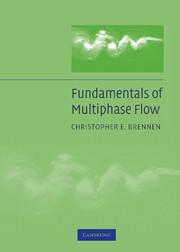Book contents
- Frontmatter
- Contents
- Preface
- Nomenclature
- 1 Introduction to Multiphase Flow
- 2 Single-Particle Motion
- 3 Bubble or Droplet Translation
- 4 Bubble Growth and Collapse
- 5 Cavitation
- 6 Boiling and Condensation
- 7 Flow Patterns
- 8 Internal Flow Energy Conversion
- 9 Homogeneous Flows
- 10 Flows with Bubble Dynamics
- 11 Flows with Gas Dynamics
- 12 Sprays
- 13 Granular Flows
- 14 Drift Flux Models
- 15 System Instabilities
- 16 Kinematic Waves
- Bibliography
- Index
1 - Introduction to Multiphase Flow
Published online by Cambridge University Press: 05 June 2014
- Frontmatter
- Contents
- Preface
- Nomenclature
- 1 Introduction to Multiphase Flow
- 2 Single-Particle Motion
- 3 Bubble or Droplet Translation
- 4 Bubble Growth and Collapse
- 5 Cavitation
- 6 Boiling and Condensation
- 7 Flow Patterns
- 8 Internal Flow Energy Conversion
- 9 Homogeneous Flows
- 10 Flows with Bubble Dynamics
- 11 Flows with Gas Dynamics
- 12 Sprays
- 13 Granular Flows
- 14 Drift Flux Models
- 15 System Instabilities
- 16 Kinematic Waves
- Bibliography
- Index
Summary
Introduction
Scope
In the context of this book, the term multiphase flow is used to refer to any fluid flow consisting of more than one phase or component. For brevity and because they are covered in other texts, we exclude those circumstances in which the components are well mixed above the molecular level. Consequently, the flows considered here have some level of phase or component separation at a scale well above the molecular level. This still leaves an enormous spectrum of different multiphase flows. One could classify them according to the state of the different phases or components and therefore refer to gas/solids flows or liquid/solids flows or gas/particle flows or bubbly flows and so on; many texts exist that limit their attention in this way. Some treatises are defined in terms of a specific type of fluid flow and deal with low-Reynolds-number suspension flows, dusty gas dynamics, and so on. Others focus attention on a specific application such as slurry flows, cavitating flows, aerosols, debris flows, fluidized beds, and so on; again, there are many such texts. In this book we attempt to identify the basic fluid mechanical phenomena and to illustrate those phenomena with examples from a broad range of applications and types of flow.
Parenthetically, it is valuable to reflect on the diverse and ubiquitous challenges of multiphase flow. Virtually every processing technology must deal with multiphase flow, from cavitating pumps and turbines to electrophotographic processes to papermaking to the pellet form of almost all raw plastics.
Information
- Type
- Chapter
- Information
- Fundamentals of Multiphase Flow , pp. 1 - 29Publisher: Cambridge University PressPrint publication year: 2005
Accessibility standard: Unknown
Why this information is here
This section outlines the accessibility features of this content - including support for screen readers, full keyboard navigation and high-contrast display options. This may not be relevant for you.Accessibility Information
- 3
- Cited by
